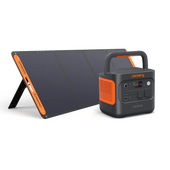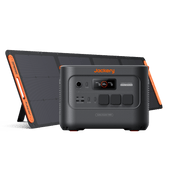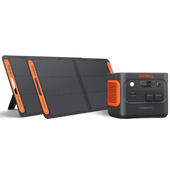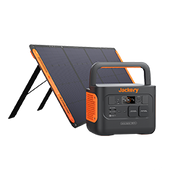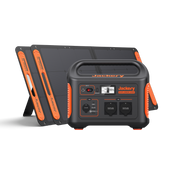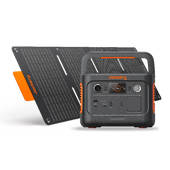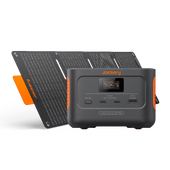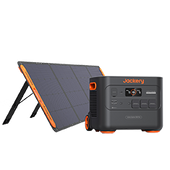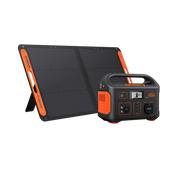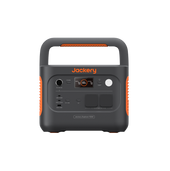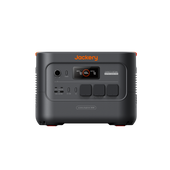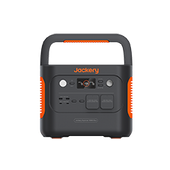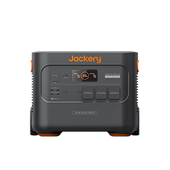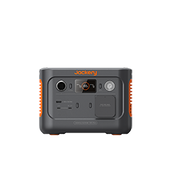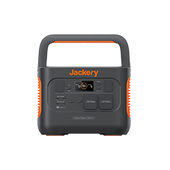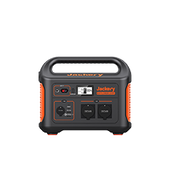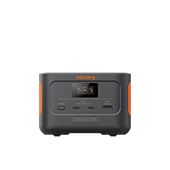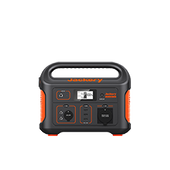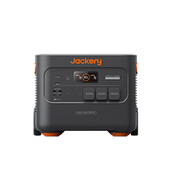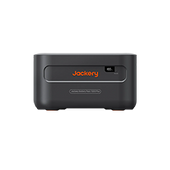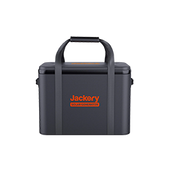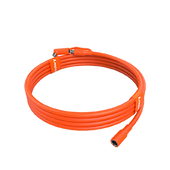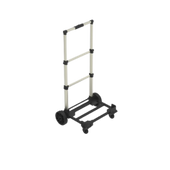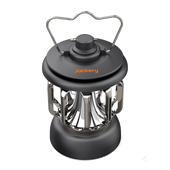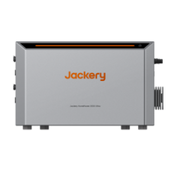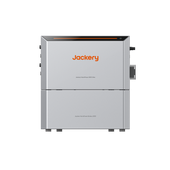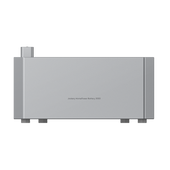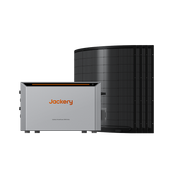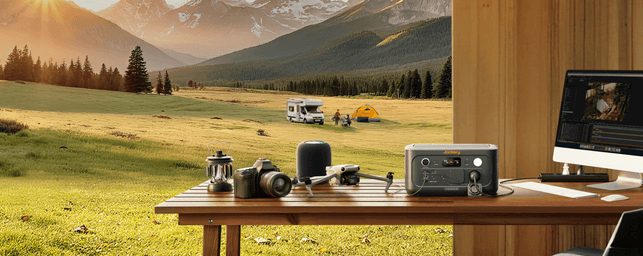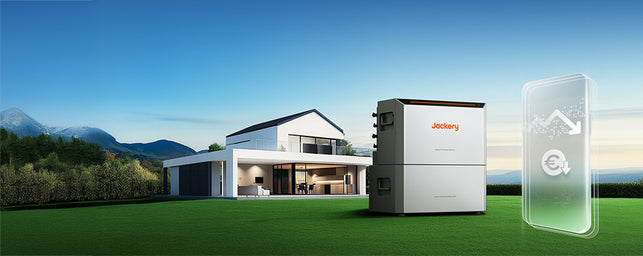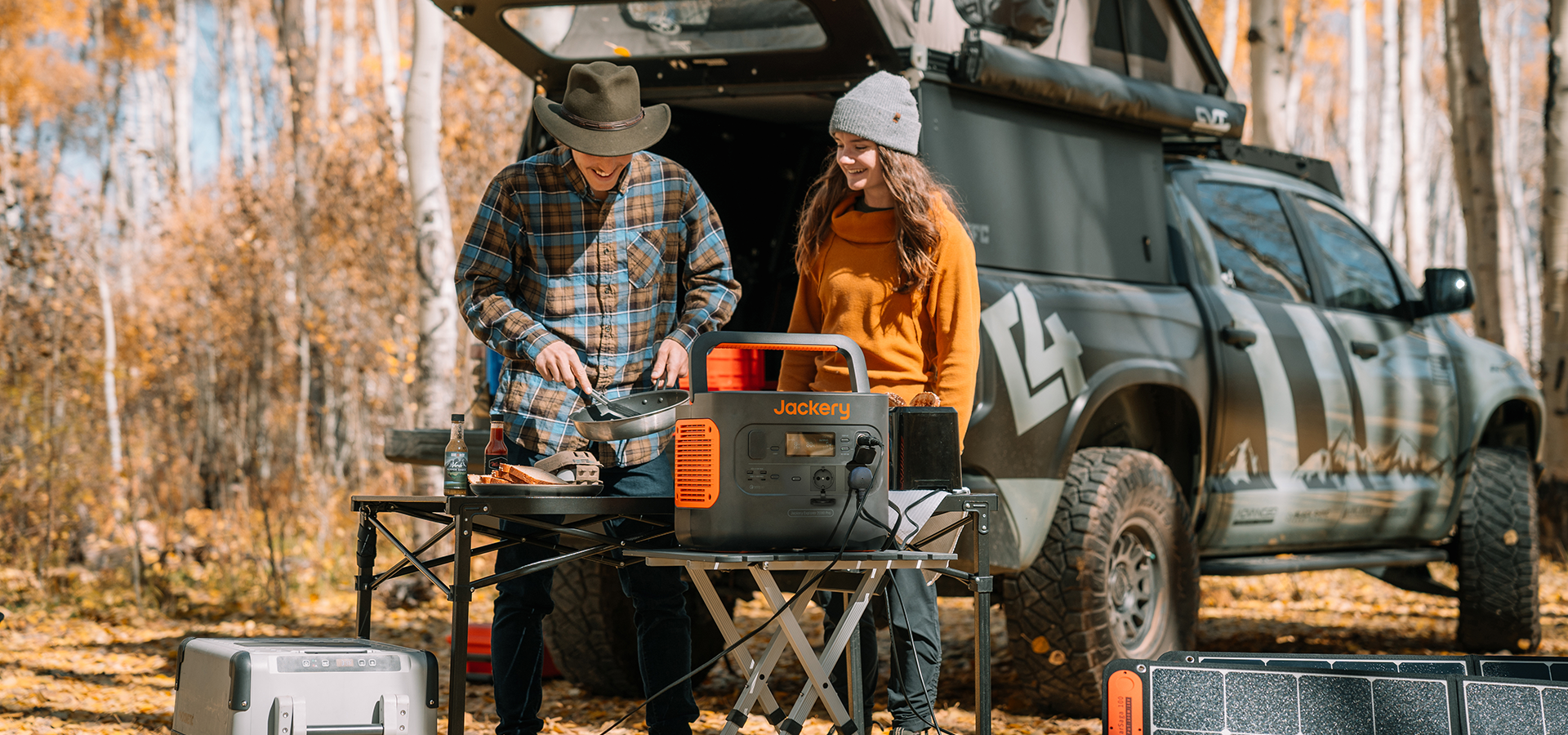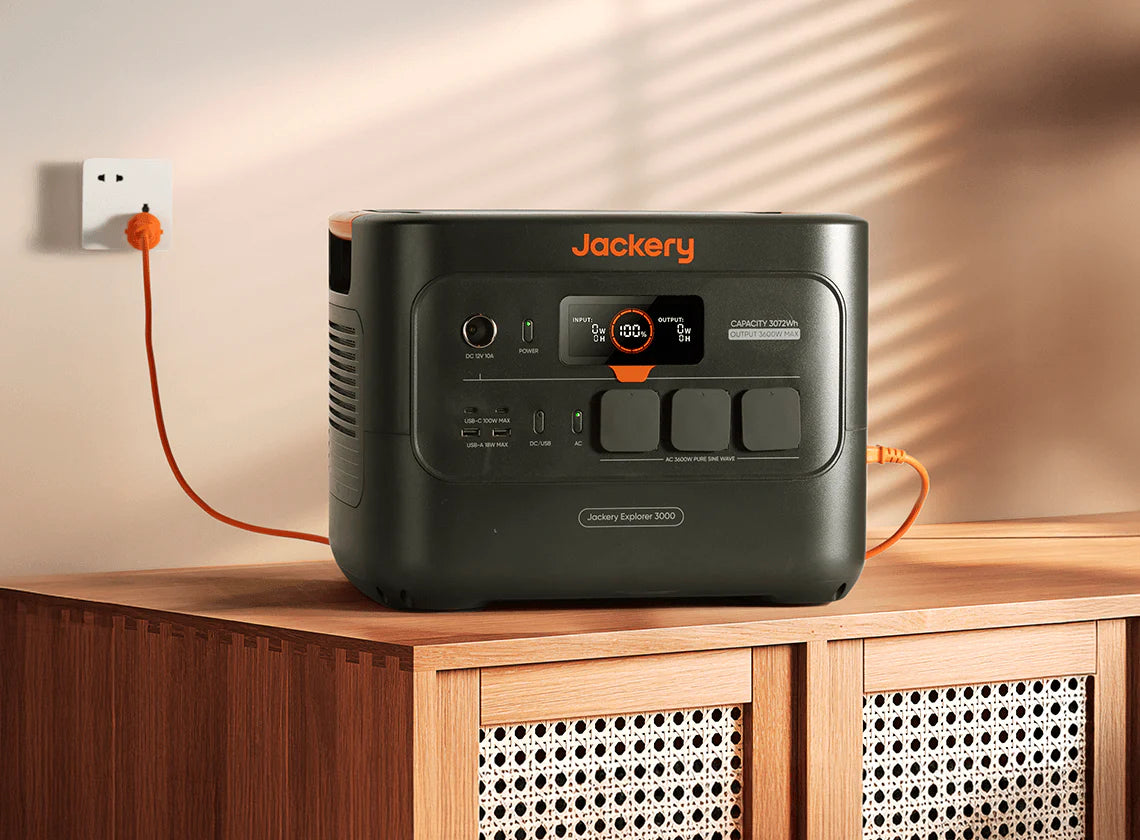Outdoor cooking, once a summer hobby, is now a cultural and economic phenomenon. From Berlin's parks to Spain's beaches, a grilling renaissance is changing how Europeans eat, socialise, and connect with nature. This is a lifestyle movement supported by a rapidly growing market. This movement is geographically extensive. With a 20% market share, Germany is the continent's grilling leader, followed by the UK, France, Spain, and Italy.[1]
Under this boom, key trends are shaping European barbecuing. While gas (45%) and charcoal (35%) grills still command the market, the electric grill segment, at 15%, is growing the quickest.[1] This surge is a direct response to stricter open-flame grilling regulations; the convenience and clean-burning nature of electric models make them an ideal solution. When paired with a portable solar generator, they offer unparalleled freedom from the grid. This guide will help you master the modern camping, barbecue, and grill experience across the continent's challenging landscape.
The Rules of the Grill: A Practical Guide to European BBQ Regulations
Navigating the world of outdoor grilling in Europe requires an understanding of a complex patchwork of local laws, park rules, and social etiquette. There is no single "European BBQ law." Instead, enthusiasts must contend with a varied landscape of regulations that prioritise safety, environmental protection, and consideration for others.
1. Public Parks: The "Designated Zone" is Key
Across the continent, the concept of the "designated zone" is paramount for grilling in public parks. This principle is most clearly seen in Germany, where grilling is generally prohibited except within specially signposted areas known as Grillplätze.[2] This permission comes with strict responsibilities: users must bring their own portable grill (disposable models are often banned), open fires are forbidden, and all embers and trash must be extinguished and packed out. Violations can lead to significant fines.
This model appears elsewhere. In France, a general rule forbids lighting a fire within 200 meters of wooded areas, but some parks provide dedicated areas.[3] In Spain, major urban parks often ban grilling, but specific recreational areas on the outskirts are equipped with public BBQ kitchen facilities. The universal rule is clear: if an area is not explicitly marked as a designated grilling zone, you must assume it is forbidden.
2. National Parks & Wilderness: Strict "Fire Ban" Policies are the Norm
In Europe's national parks, the regulatory environment becomes even more stringent, with the overwhelming priority being the prevention of wildfires. This leads to near-universal bans on open flames, especially during dry summer months. Ireland’s National Parks & Wildlife Service, for instance, enforces an explicit ban on all fires and BBQs within its protected landscapes. In Scandinavia, the celebrated "right to roam" does not grant an automatic right to make a fire; fires are permissible only in pre-established, designated fire pits and are always subordinate to local weather conditions and fire warnings. A high fire risk declaration, such as Germany's Forest Fire Danger Level 4, results in a total ban on all public barbecuing, even within permitted Grillplätze.
3. Balconies & Gardens: The "Neighbour-Friendly" Approach
For those grilling in more confined urban spaces, the legal framework shifts from environmental protection to social consideration. No pan-European law explicitly prohibits barbecuing on a private balcony or in a garden. Instead, the practice is governed by local ordinances, rental contracts, and broad "nuisance" laws. The critical factor is almost always smoke. Excessive smoke drifting into a neighbour's home can be legally defined as an "abnormal neighbourhood disturbance".
Consequently, charcoal grills, which produce the most smoke, are the most likely to cause conflict and are often explicitly forbidden in rental agreements. Gas and, particularly, electric grills are overwhelmingly recommended for their low-smoke operation, with electric models often being the only type explicitly permitted by building regulations. Across all these spheres, the electric grill consistently emerges as the most compliant and lowest-risk option, the master key to unlocking the widest range of grilling locations.

Choosing Your Grill: Flavour vs. Freedom in a Portable World
The modern griller's choice of a portable grill is a trade-off between the allure of authentic flavour and the practical demands of convenience, safety, and compliance. While traditionally a duel between charcoal and gas, the rise of the electric grill has introduced a transformative contender.
1. Charcoal Grills: The Purist's Choice
o Pros: Charcoal delivers the most authentic, smoky taste, which many traditionalists consider the essence of barbecue. They are also typically the most affordable and portable option.
o Cons: This flavour comes at a significant cost. Charcoal is messy, with ash disposal being a major logistical challenge in public parks. It requires a long setup time, produces a large volume of smoke unsuitable for balconies, and emits carcinogenic compounds.
2. Gas Grills: The Convenient Compromise
o Pros: Offering near-instant ignition and precise temperature control, gas grills are exceptionally easy to use and much cleaner than charcoal. They provide a good balance of user-friendliness and satisfying grilled flavour.
o Cons: Gas grills still produce flare-ups, and their portability is hampered by the need to carry bulky propane tanks. Environmentally, they rely on a non-renewable fossil fuel.
3. Electric Grills: The Modern Solution
o Pros: Electric grills are the epitome of safety and convenience. With no open flame, there is zero risk of flare-ups, no messy ash, and no carcinogens from the fuel source. They heat up incredibly quickly, offer the most precise temperature control, and their minimal smoke production makes them the most compliant and neighbor-friendly option for the vast majority of European settings. When powered by renewable energy, they are also the most environmentally sound choice.
o Cons: The primary drawback cited by purists is the lack of "authentic" smoky flavour that comes from combustion.
The "Power Paradox"
This analysis reveals a compelling paradox. The electric grill is the definitive solution to nearly every challenge faced by the modern European griller, from navigating regulations to ensuring safety and ease of use. Yet, it is tethered by a power cord. This single vulnerability—the "Power Paradox"—is the final barrier to absolute grilling freedom. The safest, cleanest, and most compliant grill is rendered useless in the very places it is most needed: the beautiful, remote park, the pristine beach, or the off-grid campsite far from any wall socket.
Unleash Your Grill with a Jackery Solar Generator
The Power Paradox presents a clear challenge: the ideal grilling technology is electric, but its use is constrained by power availability. The solution is not to abandon the superior technology but to bring the power to the grill. This is the freedom offered by Jackery's range of portable solar generators. By providing clean, silent, and reliable electricity anywhere, a Jackery portable power station resolves the paradox, empowering enthusiasts to enjoy their camping BBQ wherever adventure calls.
1. Jackery Solar Generator 3000 v2
For the serious outdoor connoisseur or host of a large BBQ party, the Jackery Solar Generator 3000 v2 is engineered for maximum power. Its massive 3072Wh LiFePO4 battery and formidable 3600W continuous output (7200W surge) can effortlessly handle the most power-hungry electric grills alongside other appliances like refrigerators and lights. Built for durability with a lifespan of over 4000 charge cycles, it recharges from an AC outlet in a class-leading 1.8 hours. Despite its immense power, integrated wheels and a retractable handle ensure mobility.
2. Jackery Solar Generator 2000 v2
The Jackery Solar Generator 2000 v2 strikes the perfect balance between high performance and enhanced portability, making it the ideal all-around solar generator for weekend campers and versatile adventurers. Its 2042Wh LiFePO4 battery and 2200W continuous output (4400W surge) are the sweet spot for the vast majority of portable electric grills. It shares the same durable battery technology and fast-charging capabilities as its larger sibling, but in a more manageable 17.9 kg package that is easier to carry and pack.
3. Jackery Solar Generator 1000 v2
Designed for spontaneity and ultimate ease of transport, the Jackery Solar Generator 1000 v2 is the perfect power solution for city dwellers and day-trippers. Its 1070Wh battery and 1500W continuous output (3000W surge) are perfectly matched for the new generation of efficient portable e-grills, coolers, and speakers. It stands out with its ability to supercharge from 0 to 100% in an astonishing 1.6 hours, making it ideal for last-minute adventures. Weighing just 10.8 kg, it is the undisputed choice for trips to the local park or a walk to the beach.

The Ultimate European BBQ Checklist
A successful outdoor grilling adventure is born from thoughtful preparation. This tiered checklist will ensure you have everything you need for a perfect day, from a simple buiten BBQ to an elaborate off-grid feast.
Tier 1: Core Cooking Gear
This is the foundation of your mobile outdoor kitchen.
- The Grill: A high-quality portable electric grill is the cornerstone of the modern setup.
- The Power Source: Your chosen Jackery Solar Generator—the 1000 v2 for portability, the 2000 v2 for versatility, or the 3000 v2 for maximum power. For multi-day trips, add portable Jackery SolarSaga panels for sustainable recharging.
- The Tools: Essential tools include long-handled tongs, a spatula, a grill brush, skewers, and a basting brush. A reliable instant-read meat thermometer is non-negotiable for food safety. Pack at least two cutting boards—one for raw meat and one for cooked food—to prevent cross-contamination.
Tier 2: Food, Drinks & Cold Storage
With the hardware sorted, the focus shifts to the feast.
- Cold Storage: A high-quality cooler is critical for food safety. Pre-chill it, use frozen gel packs, and pack raw meat in sealed containers at the very bottom.
- The Feast: Elevate your BBQ party by drawing inspiration from Europe's rich grilling traditions. Try German Schwenkbraten (marinated pork steaks), British Cumberland sausages and rosemary lamb chops, French Merguez sausages, or Spanish Pincho ribs.
- The Drinks: Complement your meal with a refreshing German Radler, a crisp French rosé, or a pitcher of Spanish sangria.
Tier 3: The Jackery-Powered Experience Upgrade
This is where the Jackery ecosystem transforms a simple cookout into a modern, comfortable gathering.
- The Portable Electric Cooler: Powered by your Jackery, an electric cooler keeps food and drinks perfectly chilled for your entire trip without the need for ice.
- Ambience and Entertainment: As dusk falls, plug in a string of LED lights to create a warm atmosphere and power a portable speaker for a soundtrack to your evening.
- Stay Connected: Keep all your essential devices—smartphones, cameras, and drones—fully charged to navigate, stay in touch, and capture the memories you're creating.

Grill Safe, Grill Smart: The Responsible Griller's Code
A successful barbecue is not just delicious, but one that ensures the well-being of your guests and leaves the natural environment untouched.
Key Outdoor Food Safety Rules
The risk of foodborne illness increases outdoors. Adhere to these four core principles:
- Clean: Use hand sanitiser if soap and water aren't available. Ensure all utensils and surfaces are thoroughly cleaned before and after contact with food.
- Chill: Keep perishable foods in a cooler below 5°C (40°F). Never leave food in the "Danger Zone" (between 5°C and 60°C) for more than two hours.[4]
- Cook: A meat thermometer is the only reliable way to ensure meat is cooked to a safe internal temperature, killing harmful bacteria. Poultry should reach 74°C (165°F), and ground meats 71°C (160°F).[5]
- Separate: Use separate cutting boards, plates, and utensils for raw and cooked foods to prevent cross-contamination.
The "Leave No Trace" Principle for Grillers
The Leave No Trace Seven Principles provide an essential ethical framework for minimising our impact.
- Plan Ahead & Prepare: Know the specific regulations of the area you are visiting before you leave home.
- Dispose of Waste Properly: This is the "pack it in, pack it out" philosophy. All food scraps, packaging, and litter must be packed out with you.
- Minimise Campfire Impacts: The Leave No Trace Centre explicitly recommends using a lightweight stove for cooking to avoid the lasting scars of a campfire. An electric grill powered by a portable power station is the ultimate modern embodiment of this principle, leaving no scorch marks, producing no ash, and eliminating the need to gather firewood.
- Be Considerate of Other Visitors: The quiet, smoke-free operation of an electric grill ensures your delicious meal does not disturb fellow park-goers or campers with noise or smoke.
When viewed through the combined lens of food safety and environmental ethics, the combination of a portable electric grill and a Jackery Solar Generator emerges as the unequivocally superior choice for modern outdoor cooking. It virtually eliminates wildfire risks, introduces no chemical contaminants, produces no physical waste like ash, and shows the utmost respect for nature and fellow humans.
Conclusion
European outdoor cooking is alive and growing, but it is constrained by environmental protections. Modern grillers must balance fun and stewardship.
Technology evolution is the answer. The change to clean, efficient, and low-impact electric grilling satisfies European rules' safety and social concerns. This superior technology was power corded. This gap is closed by Jackery. By solving the "Power Paradox," Jackery Solar Generators unleash the full potential of the modern camping barbecue and grilling movement by offering clean, portable, silent electricity.
References
[1] https://markwideresearch.com/europe-barbeque-grill-market/
[2] https://www.berlin.de/sen/uvk/en/nature-and-green/urban-green-space/public-parks/use-rules-and-services/
[3] https://aluvy-design.com/en/blogs/nos-astuces/4-spots-ou-faire-un-barbecue
[4] https://www.fsis.usda.gov/food-safety/safe-food-handling-and-preparation/food-safety-basics/food-safety-while-hiking-camping
[5] https://desertridgelifestyles.org/food-safety-for-a-great-outdoor-experience/

